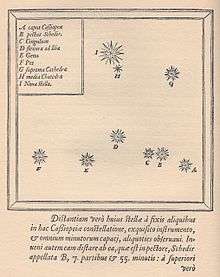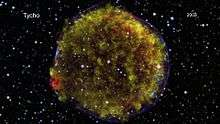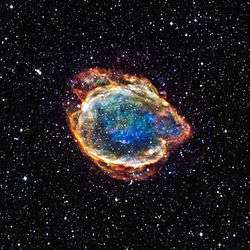SN 1572
| SN 1572 | |
|---|---|
|
Remnant of SN 1572 as seen in X-ray light from the Chandra X-ray Observatory | |
| Observation data (Epoch ?) | |
| Supernova type | Type Ia[1] |
| Remnant type | Nebula |
| Host galaxy | Milky Way |
| Constellation | Cassiopeia |
| Right ascension | 0h 25.3m |
| Declination | +64° 09′ |
| Galactic coordinates | G.120.1+1.4 |
| Discovery date | November 1572 |
| Peak magnitude (V) | −4 |
| Distance | between 8,000 ly (2.5 kpc) and 9,800 ly (3.0 kpc) |
| Physical characteristics | |
| Progenitor | Unknown |
| Progenitor type | Unknown |
| Colour (B-V) | Unknown |
| Other SNe | |
| Preceded by | SN 1181 |
| Succeeded by | SN 1604 |
SN 1572 (Tycho's Supernova, Tycho's Nova), "B Cassiopeiae" (B Cas), or 3C 10 was a supernova of Type Ia[1] in the constellation Cassiopeia, one of about eight supernovae visible to the naked eye in historical records. It appeared in early November 1572 and was independently discovered by many individuals.[2]
Historic description

The appearance of the Milky Way supernova of 1572 belongs among the more important observation events in the history of astronomy. The appearance of the "new star" helped to revise ancient models of the heavens and to speed on a revolution in astronomy that began with the realisation of the need to produce better astrometric star catalogues (and thus the need for more precise astronomical observing instruments). It also challenged the Aristotelian dogma of the unchangeability of the realm of stars.
The supernova of 1572 is often called "Tycho's supernova", because of Tycho Brahe's extensive work De nova et nullius aevi memoria prius visa stella ("Concerning the Star, new and never before seen in the life or memory of anyone", published in 1573 with reprints overseen by Johannes Kepler in 1602, and 1610), a work containing both Tycho Brahe's own observations and the analysis of sightings from many other observers. Tycho was not the first to observe the 1572 supernova, although he was probably the most accurate observer of the object. Almost as accurate were his European colleagues, such as Wolfgang Schuler, Thomas Digges, John Dee, Francesco Maurolico, Jerónimo Muñoz,[3] Tadeáš Hájek, or Bartholomäus Reisacher.[4]
In England, Queen Elizabeth summoned the mathematician and astrologer Thomas Allen, "to have his advice about the new Star that appeared in the Cassiopeia to which he gave his Judgement very learnedly", as the antiquary John Aubrey recorded in his memoranda a century later.[5]
In Ming dynasty China, the star became an issue between Zhang Juzheng and the young Wanli Emperor: in accordance with the cosmological tradition, the emperor was warned to consider his misbehavior, since the new star was interpreted as an evil omen.[6]
The more reliable contemporary reports state that the new star itself burst forth sometime between November 2 and 6, in 1572, when it rivalled Venus in brightness.[7] The supernova remained visible to the naked eye into 1574, gradually fading until it disappeared from view.[7]
Supernova remnant



The distance to the supernova remnant has been estimated to between 2 and 5 kpc (approx. 6,500 and 16,300 light-years), but recent studies suggest a value closer to 2.5 and 3 kpc (approx. 8,000 and 9,800 light-years).[9]
Radio detection
The search for a supernova remnant was negative until 1952, when Hanbury Brown and Hazard reported a radio detection at 158.5 MHz, obtained at the Jodrell Bank Observatory.[10] This was confirmed, and its position more accurately measured, by Baldwin and Edge (1957) using the Cambridge Radio Telescope working at a wavelength of 1.9 m,[11] and the remnant was also identified tentatively in the second Cambridge radio-source catalogue as object "2C 34," and identified more firmly as "3C 10" in the third Cambridge list (Edge et al. 1959). There is no dispute that 3C 10 is the remnant of the supernova observed in 1572–1573. Following a review article by Minkowski (1964),[12] the designation 3C 10 appears to be that most commonly used in the literature when referring to the radio remnant of B Cas (though some authors use the tabulated Galactic designation G120.7+2.1 of Green 1984, and many authors commonly refer to it as "Tycho's supernova remnant"). Because the radio remnant was reported before the optical supernova-remnant wisps were discovered, the designation 3C 10 is used by some to signify the remnant at all wavelengths.
Optical detection
The supernova remnant of B Cas was discovered in the 1960s by scientists with a Palomar Mountain telescope as a very faint nebula. It was later photographed by a telescope on the international ROSAT spacecraft. The supernova has been confirmed as Type Ia,[1] in which a white dwarf star has accreted matter from a companion until it approaches the Chandrasekhar limit and explodes. This type of supernova does not typically create the spectacular nebula more typical of Type II supernovas, such as SN 1054 which created the Crab Nebula. A shell of gas is still expanding from its center at about 9,000 km/s. A recent study indicates a rate of expansion below 5,000 km/s.[13]
Discovery of the companion star
In October 2004, a letter in Nature reported the discovery of a G2 star, similar in type to our own Sun.[14] It is thought to be the companion star that contributed mass to the white dwarf that ultimately resulted in the supernova. A subsequent study, published in March 2005, revealed further details about this star: labeled Tycho G, it was probably a main-sequence star or subgiant before the explosion, but some of its mass was stripped away and its outer layers were shock-heated by the supernova. Tycho G's current velocity is perhaps the strongest evidence that it was the companion star to the white dwarf, as it is traveling at a rate of 136 km/s, which is more than four times faster than the mean velocity of other stars in its stellar neighbourhood. This find has been challenged in recent years. The star is relatively far away from the center and does not show rotation which might be expected of a companion star.
Observation of light echo
In September 2008, the Subaru telescope obtained the optical spectrum of Tycho Brahe's supernova near maximum brightness from a scattered-light echo.[1] It has been confirmed that SN 1572 belongs to the majority class of normal SNe Ia.
X-ray observation
An X-ray source designated Cepheus X-1 (or Cep X-1) was detected by the Uhuru X-ray observatory at 4U 0022+63. Earlier catalog designations are X120+2 and XRS 00224+638. Cepheus X-1 is actually in the constellation Cassiopeia, and it is SN 1572, the Tycho SNR.[15]
In literature
In the ninth episode of James Joyce's Ulysses, Stephen Dedalus associates the appearance of the supernova with the youthful William Shakespeare, and in the November 1998 issue of Sky & Telescope, three researchers from Southwest Texas State University, Don Olson and Russell Doescher of the Physics Department and Marilynn Olson of the English Department, argued that this supernova is described in Shakespeare's Hamlet, specifically by Bernardo in Act I, Scene i.[16]
The protagonist in Arthur C. Clarke's 1955 short story "The Star" casually mentions the supernova. It is a major element in Frederik Pohl's spoof science article, "The Martian Star-Gazers", first published in Galaxy Science Fiction Magazine in 1962.
See also
| Wikimedia Commons has media related to Tycho's Supernova. |
References
- 1 2 3 4 Krause, Oliver; et al. (2008). "Tycho Brahe's 1572 supernova as a standard type Ia as revealed by its light-echo spectrum". Nature. 456 (7222): 617–619. arXiv:0810.5106
 . Bibcode:2008Natur.456..617K. doi:10.1038/nature07608. PMID 19052622.
. Bibcode:2008Natur.456..617K. doi:10.1038/nature07608. PMID 19052622. - ↑ Blast From The Past: Astronomers Resurrect 16th-Century Supernova ScienceDaily (Dec. 4, 2008)
- ↑ Jerónimo Muñoz (1573). Libro del nuevo Cometa, y del lugar donde se hazen; y como se vera por las Parallaxes quan lexos estan de tierra; y del Prognostico deste. Valencia.
- ↑ De mirabili Novae ac splendidis stellae, Mense Nouembri anni 1572, primum conspectæ, ac etiam nunc apparentis, Phœnomeno
- ↑ Oliver Lawson Dick, ed., Aubrey's Brief Lives. Edited from the Original Manuscripts, 1949, s.v. "Thomas Allen" p. 5.
- ↑ Science and Civilization in China, v.3 pp.425-6; cf. 1587, a Year of No Significance.
- 1 2
- ↑ Williams, Brian J; Chomiuk, Laura; Hewitt, John W; Blondin, John M; Borkowski, Kazimierz J; Ghavamian, Parviz; Petre, Robert; Reynolds, Stephen P (April 6, 2016). "An X-ray and Radio Study of the Varying Expansion Velocities in Tycho's Supernova Remnant". arXiv:1604.01779
 [astro-ph.HE].
[astro-ph.HE]. - ↑ Wenwu Tian; Denis A. Leahy (December 26, 2010). "Tycho SN 1572: A Naked Ia Supernova Remnant without Associated Ambient Molecular Cloud". Astrophysical Journal Letters. 729: L15. arXiv:1012.5673
 . Bibcode:2011ApJ...729L..15T. doi:10.1088/2041-8205/729/2/L15.
. Bibcode:2011ApJ...729L..15T. doi:10.1088/2041-8205/729/2/L15. - ↑ Hanbury-Brown, R.; Hazard, C. (1952). "Radio-Frequency Radiation from Tycho Brahe's Supernova (A.D. 1572)". Nature. 170 (4322): 364–365. Bibcode:1952Natur.170..364H. doi:10.1038/170364a0.
- ↑ Baldwin, J. E.; Edge, D. O. (1957). "Radio emission from the remnants of the supernovae of 1572 and 1604". The Observatory. 77: 139–143. Bibcode:1957Obs....77..139B.
- ↑ Minkowski, R. (1964). "Supernovae and Supernova Remnants". Annual Review of Astronomy and Astrophysics. 2 (1): 247–266. Bibcode:1964ARA&A...2..247M. doi:10.1146/annurev.aa.02.090164.001335.
- ↑ Asami Hayato; Hiroya Yamaguchi; Toru Tamagawa; Satoru Katsuda; Una Hwang; John Patrick Hughes; Midori Ozawa; Aya Bamba; Kenzo Kinugasa (2010). "Expansion Velocity of Ejecta in Tycho's Supernova Remnant Measured by Doppler Broadened X-ray Line Emission". arXiv:1009.6031
 [astro-ph.HE].
[astro-ph.HE]. - ↑ Ruiz-Lapuente, Pilar; et al. (2004). "The binary progenitor of Tycho Brahe's 1572 supernova". Nature. 431 (7012): 1069–1072. arXiv:astro-ph/0410673
 . Bibcode:2004Natur.431.1069R. doi:10.1038/nature03006. PMID 15510140.
. Bibcode:2004Natur.431.1069R. doi:10.1038/nature03006. PMID 15510140. - ↑ Wood KS; Meekins JF; Yentis DJ; Smathers HW; McNutt DP; Bleach RD (December 1984). "The HEAO A-1 X-ray source catalog". Ap J Suppl Ser. 56 (12): 507–649. Bibcode:1984ApJS...56..507W. doi:10.1086/190992.
- ↑ http://www.txstate.edu/news/news_releases/news_archive/1998/09/supernova092898.html
External links
- NASA Astronomy Picture of the Day: Tycho's Supernova Remnant (17 March 2009)
- solstation.com: Tycho's Star
- The Search for the Companion Star of Tycho Brahe's 1572 Supernova
- cnn.com: Important days in history of universe
Coordinates: ![]() 00h 25m 21s, +64° 09′ 15″
00h 25m 21s, +64° 09′ 15″


